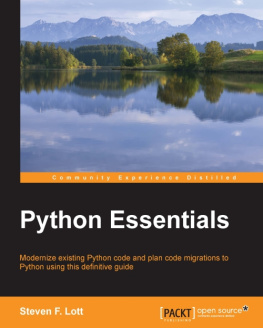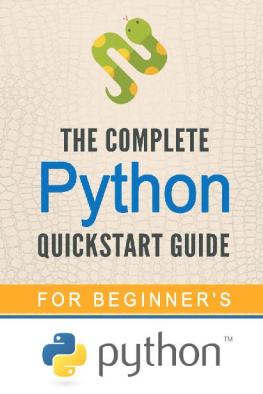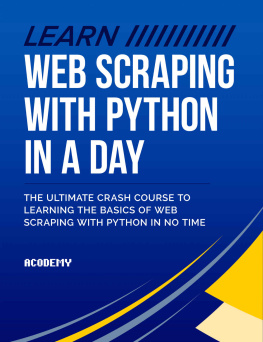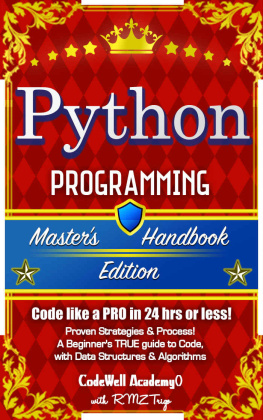Academy Life-style - Python: The Complete Python Quickstart Guide
Here you can read online Academy Life-style - Python: The Complete Python Quickstart Guide full text of the book (entire story) in english for free. Download pdf and epub, get meaning, cover and reviews about this ebook. year: 2015, genre: Computer. Description of the work, (preface) as well as reviews are available. Best literature library LitArk.com created for fans of good reading and offers a wide selection of genres:
Romance novel
Science fiction
Adventure
Detective
Science
History
Home and family
Prose
Art
Politics
Computer
Non-fiction
Religion
Business
Children
Humor
Choose a favorite category and find really read worthwhile books. Enjoy immersion in the world of imagination, feel the emotions of the characters or learn something new for yourself, make an fascinating discovery.
- Book:Python: The Complete Python Quickstart Guide
- Author:
- Genre:
- Year:2015
- Rating:4 / 5
- Favourites:Add to favourites
- Your mark:
- 80
- 1
- 2
- 3
- 4
- 5
Python: The Complete Python Quickstart Guide: summary, description and annotation
We offer to read an annotation, description, summary or preface (depends on what the author of the book "Python: The Complete Python Quickstart Guide" wrote himself). If you haven't found the necessary information about the book — write in the comments, we will try to find it.
Python: The Complete Python Quickstart Guide — read online for free the complete book (whole text) full work
Below is the text of the book, divided by pages. System saving the place of the last page read, allows you to conveniently read the book "Python: The Complete Python Quickstart Guide" online for free, without having to search again every time where you left off. Put a bookmark, and you can go to the page where you finished reading at any time.
Font size:
Interval:
Bookmark:
Python
The Complete Python Quickstart Guide For Beginne r s
Copyright 2016 by LIFE-STYLE ACADEMY - All rights reserved.
This document is geared towards providing exact and reliable information in regards to the topic and issue covered. The publication is sold with the idea that the publisher is not required to render accounting, officially permitted, or otherwise, qualified services. If advice is necessary, legal or professional, a practiced individual in the profession should be ordered.
- From a Declaration of Principles which was accepted and approved equally by a Committee of the American Bar Association and a Committee of Publishers and Associations.
In no way is it legal to reproduce, duplicate, or transmit any part of this document in either electronic means or in printed format. Recording of this publication is strictly prohibited and any storage of this document is not allowed unless with written permission from the publisher. All rights reserved.
The information provided herein is stated to be truthful and consistent, in that any liability, in terms of inattention or otherwise, by any usage or abuse of any policies, processes, or directions contained within is the solitary and utter responsibility of the recipient reader. Under no circumstances will any legal responsibility or blame be held against the publisher for any reparation, damages, or monetary loss due to the information herein, either directly or indirectly.
Respective authors own all copyrights not held by the publisher.
The information herein is offered for informational purposes solely, and is universal as so. The presentation of the information is without contract or any type of guarantee assurance.
The trademarks that are used are without any consent, and the publication of the trademark is without permission or backing by the trademark owner. All trademarks and brands within this book are for clarifying purposes only and are the owned by the owners themselves, not affiliated with this document.
Table of Contents
I want to thank you and congratulate you for downloading the book , PYTHON: The Complete Python Quickstart Guide For Beginne rs .
This book contains proven steps and strategies on learning Python Programming quickly.
Unlike other programming language, Python emphasizes on the readability of codes. It uses a precise syntax that enables programmers, beginners and experts alike, to write fewer codes in coming up with the functions for a desired program. The best thing about Python is its universality: you can code an application using one platform but still be able to run it using other platforms. This is unlike other programming languages that promise platform independence but still manages to fall short of expectations.
The Complete Python Quickstart Guide for Beginners is all about providing you with all the necessary basics of Python. Everything that you must know in order to become productive in your line of work is in this book. Examples provided in this book are specific and relevant that you may encounter them in the ordinary course of performing your jobs.
A crash course on Python will only give you the framework of the language but will never make you appreciate the beauty of the language as much as Python Programming for Beginners will.
If you are still thinking twice about learning Python, perhaps what will convince you is a list of organizations using Python as part of their programming: (a) Alice Education Software, (b) Fermilab, (c) Go.com, (d) Google, (e) National Space and Aeronautics Administration, (f) New York Stock Exchange, (g) ObjectDomain, (h) Redhat, (i) Yahoo! and (j) Youtube.
This book will be your guide in anything and everything Python such that by the time you put down this book, you will be confident in performing tasks that require Python programming!
Thanks again for downloading this book. I hope you enjoy it!
Chapter 1. Understanding Python
There are many programming languages being used today, so much so that it would be near-impossible to learn about every single one. It's easy to think that programmers would be contented with all the languages available to communicate with the computer but the truth is, new languages are born every year.
Creating a new programming language isn't just out of whim. Programmers create a new one for a good reason. Each programming language specializes on specific functions. Also as computer hardware evolves, so does computer software and thus, codes and programming language. In order to keep up with this continuous evolution, programmers create a new language that will streamline the communication between hardware and software. For instance, in achieving a more appropriately-designed interface, some programmers build a different computer language after acknowledging the limitations of the ones that are available.
There are certain functions that Python excels in so it is important for you to know what these functions are. Part of getting acquainted with a programming language is learning about its strengths and weaknesses.
Programming languages are constructed by programmers for specific reasons. The goals they have in mind help shape the language and determine the flexibility and usability of the language. Python was created with the objective to create a language that can be used by programmers in creating codes that are productive and efficient.
Here are the reasons you will want to use Python when coding an application:
(a) Less Development Time
Compared to other similar programming language like Java and C/C++, codes used in Python are 5 to 10 times shorter. This makes Python less complicated but more efficient. It also means that you spend less time and effort in developing your application and more time toying with it.
(b) Less Learning Time
The main goal of the makers of Python is to create a language that has fewer unusual rules which make it hard for beginners to learn a language. This will help programmers create more usable applications that they can't do with more complicated and obscure language.
(c) Ease of reading
When checking for errors or bugs, it is important that the language is easier to read and understand. It is hard to code and check a program code, if language is too complicated. Python codes are easier to write and read than any other languages available today. This will make it easier for you to interpret the code and make necessary changes.
Also, here are suggested specific uses for Python:
(a) Scripting browser-based applications
(b) Creating better user interfaces
(c) Creating rough application examples
(d) Working with XML
(e) Designing scientific, mathematic and engineering applications
(f) Interacting with databases
Sometimes, comparing a programming language to other languages can be very subjective. The difference is usually a matter of personal preference but there are times that the comparison can be supported by quantifiable scientific data.
Before you read this section, it is important to note that there is no best all-encompassing language in the world. All you have to do is find a language that works best for a specific function or goal in mind.
(1) C#
There are claims that the people behind Microsoft simply replicated Java in creating C#. Be that as it may, C# has upsides and downsides compared to Java. According to Microsoft, their main goal in creating C# is to create a better version of C/C++. When pitted against C#, Python enjoys the following advantages:
(a) Better engineering and scientific applications
(b) More extendable when using C/C++ and Java
Font size:
Interval:
Bookmark:
Similar books «Python: The Complete Python Quickstart Guide»
Look at similar books to Python: The Complete Python Quickstart Guide. We have selected literature similar in name and meaning in the hope of providing readers with more options to find new, interesting, not yet read works.
Discussion, reviews of the book Python: The Complete Python Quickstart Guide and just readers' own opinions. Leave your comments, write what you think about the work, its meaning or the main characters. Specify what exactly you liked and what you didn't like, and why you think so.







